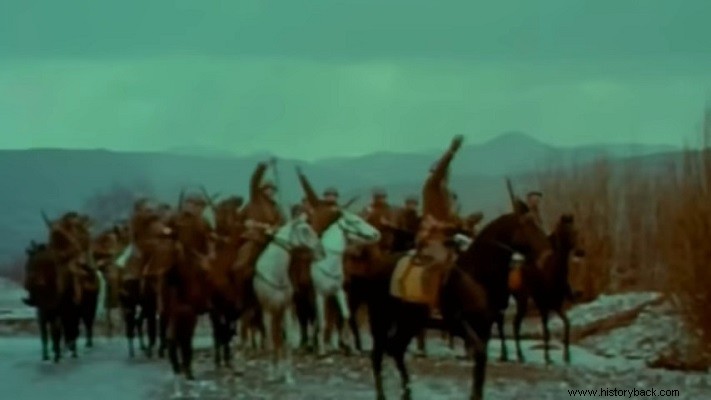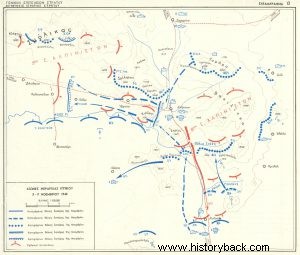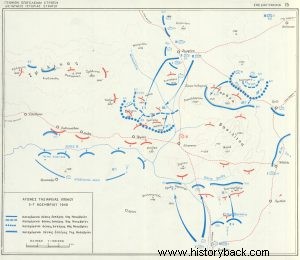
The Greco-Italian war, based on the type of operations undertaken by the two opponents, is divided into three periods. The first period, from October 28 to the middle of November 1940, concerns the event of the Italian attack and its repulsion by the Greek forces, inside the Greek territory. At the same time and based on the geographical area of the businesses, three sectors can be distinguished in which these were conducted. The sector of Epirus (from the Ionian Sea to NW Smolika mountains), Pindos (from Smolika to Grammos) and Western Macedonia. The counter-attack of the Cavalry Division was carried out during the 1st period of the Greco-Italian war, in the sector of Pindos.
The formation of the Cavalry Division during World War II
commanded by Colonel Sokratis Dimaratos, the 1st Cavalry Regiment commanded by Colonel Sotirios Papathanasiou, the 3rd Cavalry Regiment commanded by Colonel Jason Nomikos, the Motorized Cavalry Regiment commanded by Colonel Epaminondas Asimakopoulos, one Mountain A/A Artillery 20 thousand Rheinmetall , an Engineer Platoon, a Brigade and Division Transfer Platoon, a Light Vehicle Squadron, an Artillery Platoon, a Logistics Detachment, a Medical Detachment and a Veterinary Detachment.
In addition to these, other Units of the Cavalry Division that were involved in the operations until the end of the war in April 1941 were:the Mounted Machine Gun Squadron, the 65 thousand Mountain Artillery Squadron, the Mounted Artillery Squadron, 2 Ulams A/A Artillery of the 37 mm and a 75 mm Skonda Motorized Artillery. The armament of the Cavalry Regiments included Mannlicher rifles and Arabesques, Hotchkiss machine guns, Schwarzlose machine guns and Brandt mortars. During the war, the Regiments were provided with anti-tank rifles and Italian small caliber mortars.
According to the commanders' reports, drawn up at the end of the war, the armament was new and worked very well. The vehicle strength of the Motorized Cavalry Regiment included:Mercedes Benz reconnaissance vehicles, Daimler M-BLG 65/3 3 ton trucks, Chevrolet 2.5 ton trucks, other requisitioned passenger cars and mobile crews, FN tricycles (Belgian) and BMW two-wheelers.
Cavalry Regiments, as well as Artillery Squadrons, relied mainly on horse, with few vehicles. The declaration of war found the cavalry weapon in the transitional period from the horse to the motorized vehicle and this fact caused difficulties in the implementation of the war plans, especially in an area like the mountain massif of Pindos. The ability of livestock to venture over all-terrain was neutralized because it could not be easily coordinated with vehicle movements on an extremely limited road network.
Conversely, the need for stops for watering, feeding and resting the animals was an obstacle to the rapid and in-depth movement of vehicles. The Commander of the Division, Major General Georgios Stanotas, was an experienced military man, having distinguished himself with the Cavalry on the battlefields during the Balkan Wars and the Asia Minor Campaign. The commanders of the Brigade and the Cavalry Regiments of the Division had similar military experience.
Operations 1-8 November 1940
The Cavalry Division began to gather in the area between Metsovo and Kalambaka from November 1, 1940. Meanwhile, it was reinforced with the 4th Infantry Regiment, minus one battalion (Tchis Hatzidakis), with a battalion of the 7th Infantry Regiment (Tchis Papadimitriou) and a artillery of 155 thousand and was placed under the direct orders of the Chief General. The mission of the Division was the defense in the area between the heights of Koukourouza and the village of Vovousa in order to prevent the occupation of the Ioannina – Metsovo – Kalambaka road by the Italian forces heading south.
The Italians, on November 2, occupied the village of Distrato and moved further south towards Vovousa. The Division received this information from the 3/51 Company of the Pindos Detachment (Lgos Pappas), which was in Vovousa. On 3 November, units of the Division under continuous and heavy rain and without transport moved during the night into the area, where they engaged the Italian divisions. The fight continued on November 4, forcing the Italians to retreat towards Distrato, with heavy losses (35 dead, 50 captured).
The Cavalry Brigade, consisting initially of one company and the Skoda motorized artillery, moved on October 30th to Kozani where it was placed under the orders of the 2nd Army Corps and from there it was advanced on November 1st to the village of Duciko. The hill occupied the heights west of it and the artillery was placed inside the village. The mission of the Brigade was to secure the crossings from Samarina to Grevena and to pose a threat to the enemy units moving south towards Distrato from Samarina. Gradually its composition was completed.
On 2 November, the 1st Cavalry Regiment, the 2nd Reconnaissance Group (Anchis Filopoimen Kokkinos), a light unit of the Mechanized Cavalry Regiment, the Command of the 7th Infantry Regiment with the III/7th Battalion and a field artillery barrage arrived in the area. On the same day, parts of the Brigade launched an offensive against the Italians on the Reda hill, but it was repulsed. The next day, the attack was renewed with more forces and by the evening of 3 November Samarina and the heights north-west of it had been captured, cutting off the route of the 8th Mountaineer Regiment from Samarina to Distrato and Vovousa. On 4 November, the 5th Infantry Regiment joined the Brigade's strength.
The divisions of the Division and the Cavalry Brigade had succeeded in trapping the enemy in Distratos, moving from two opposite directions towards it, the Division from the south and the village of Vovousa and the Brigade from the north and the village of Samarina. From November 6, the Division was subordinated to the 1st Army Corps and was ordered to clear the area of Smolikas, acting with its maximum strength and overcoming any difficulty in supplying its units, with the first objective being the capture and liquidation of Distratos. The Commander of the Division formed a pursuit unit for this purpose.
The Cavalry Brigade, fighting against the 8th Alpinist Regiment, succeeded in repelling it from the heights of Vouzio and Gomara and from the areas of Samarina and Distratos and made contact in Distratos with the units of the Cavalry Division. On November 8, 1940, Distrato was captured by the 11th Company of the III/7th Battalion of the Cavalry Brigade. At noon, the first units of the 4th Regiment of the Cavalry Division also arrived. The Italians fled while many prisoners and wounded were captured.
Operations 9-17 November 1940
From 10 November, the enemy forces began to collapse followed closely by the divisions of the Cavalry Division and Brigade. Towards the west, from Distrato to Konitsa there was only one semi-on road:Distrato – Armata – Pades – Paleoseli – Elefthero – Konitsa. Apart from this road, from the north side, it was not possible to make movements, because the slopes of Smolikas were steep. To the south, parallel to the route was the Aoos river, whose level had risen preventing the connection of the units of the Cavalry Division with those of the VIII Division, specifically with the Anchis Frizi detachment.
However, a light part of the Cavalry Brigade (Oulamos Zarogiannis), which had advanced from the ridge of Smolika, found itself in the rear of the collapsing enemy divisions and forced them to give battle west of the village of Elefthero with the advanced Greek divisions. A mountaineer battalion of the 8th Regiment and the Italian artillery regiment supporting it were annihilated during the battle. 300 were killed and 500 captured. The Cavalry Brigade since November 11 remained at rest in Samarina, at the disposal of the 2nd Army Corps, dealing with the reconstruction of its divisions.
On November 11, parts of the Cavalry Division captured the heights east of Konitsa, after a fierce battle. From the 13th to the 16th of November, despite the Italian resistance, the Division advanced to Konitsa. The movement of all the divisions of the Division towards the villages of Paleoseli and Elefthero, which were located before Konitsa, took place under extremely adverse conditions. The difficulties of supplying food and county were great while the animals were completely exhausted and wounded. Additional food was requested for the inhabitants of the two villages who were in danger of dying of starvation due to the destruction and plundering of their stocks by the Italians.
At 07:00 on November 16, the 3rd Cavalry Regiment entered Konitsa where a large amount of armament, ammunition and six enemy guns had been abandoned. The Italians continuously bombarded the Greek units from the air, until 14:00, causing one dead and four wounded hoplites. Before withdrawing from Greek territory, the enemy fought the last battle in the village of Mazi, where he was defeated by the 3rd Cavalry Regiment. There, the Greek forces came face to face with heavy mortar and artillery fire, with many wounded around 65. Among them, the Regimental Commander, Schis Iason Nomikos, was also slightly wounded. By November 17, the Cavalry Division had driven the enemy from the national territory in its sector and the next day it would enter the Albanian territory.
The Cavalry Division and Brigade during the first phase of the operations in the Battle of Pindos, contributed to the maximum in the implementation of the plan of the Greek forces. They halted the enemy advance but also forced the enemy to retreat, disbanding much of the Mountaineer Division. These successes contributed to the revival of the morale of the fighting forces which resulted in the final total victory in the war against the Italians.
Until the end
The glorious military action of the Division and the Cavalry Brigade was not limited to the counterattack of Pindos and continued until the end of the Greco-Italian war. During its second period, specifically from November 18, 1940 to January 6, 1941, the Cavalry Division participated in the offensive struggle of the Greek Army, to push the Italians out of the national territory and pursue them inside Albania. The Division moved aggressively, achieving every objective, culminating, on December 3, 1940, with the capture of Premeti.
During the third period, from January 7, 1941 to April 5, 1941, which includes, among other things, the efforts of the Greek Army to maintain its defensive line and face the Italian Spring Offensive, the Cavalry Division during this period moved towards the area of Kortsa, where it arrived on February 24, 1941. Then and until April 3, 1941, it was defensively organized in the area of Pogradec. On April 8, 1941, and while the German attack against Greece had taken place, the General Staff ordered the Division to move towards Florina.
On April 10, it collided with the attacking German units in the area of Pisoderio and on April 15, it retreated towards Kastoria, repelling the offensive efforts of the Germans in the area of Dispilio. The collapse of the Division continued towards Metsovo where it arrived on April 20. There the Units were disbanded, due to the armistice which had been signed.


SOURCE:DIS/GES
